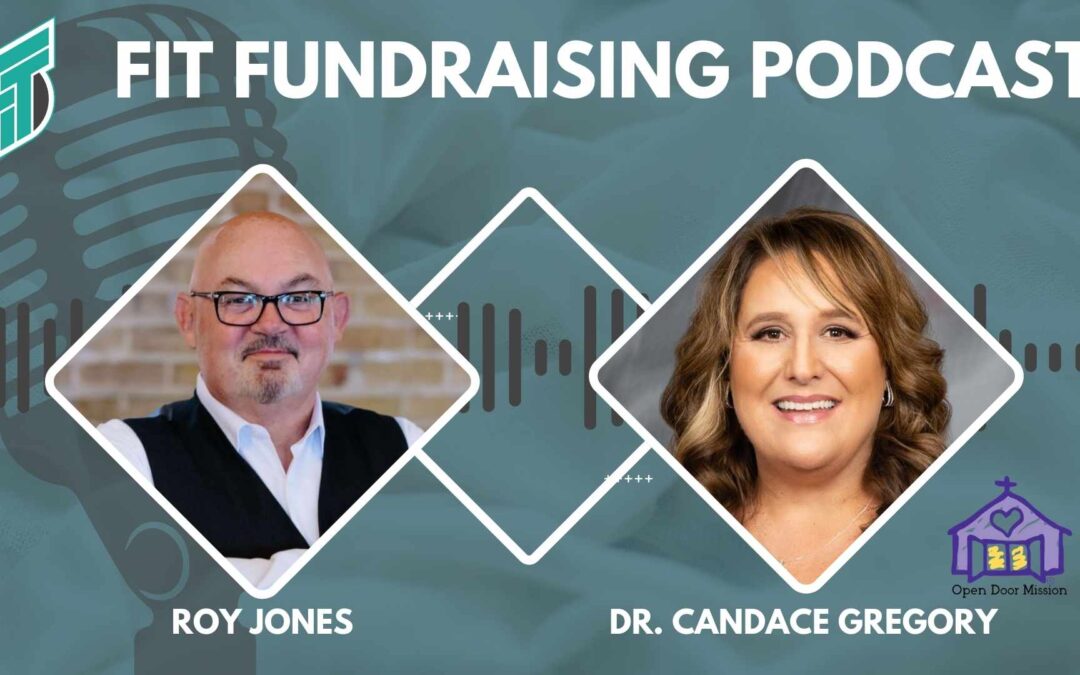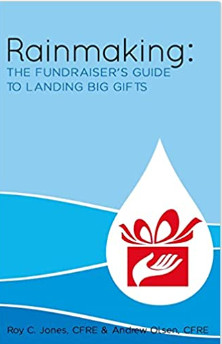INTRO: Welcome to the Fit Fundraising podcast, where we bring you game changing fundraising topics direct from our meetings with major donors and nonprofits nationwide. While most consultants are busy giving advice, Fit Fundraising stays on the front lines with non profits and major donors. This podcast is a glimpse into our world of work with non profits as we get on the field with them and successfully model fundraising.
Get ready to get fit with the hottest show in fund development, Fit Fundraising.
Roy Jones: Hello everyone, I’m Roy Jones and you’re here at the Fit Fundraising podcast. So thank you again for joining us today, I am so excited about this episode. Candace Gregory the President and CEO of the open door mission in Omaha, Nebraska is with us today. We’re gonna to be talking about capital campaigns and she has run a bunch of them and I’ve learned a lot from working with her over the years. She has been there at the open door mission since 1995, she’s built an amazing ministry. Over 28 years of experience in helping children and family ministries, she really has been an advocate for the homeless and those in need, and they just do a tremendous work. I’ve been there many times, I’ve worked with her development team a few times, and it is just exciting every time I’m with her, I learn something new about development, about ministering to donors and about truly, truly having an impact on your community. Candice, thank you so much for joining us today.
Candace Gregory: Roy, I am so blessed to be with you today and have some time to visit on this fabulous topic that I think is really an opportunity, not a challenge when it comes to capital campaign.
Roy Jones: Yeah, it really is. Take just a minute and talk about your ministry and just its growth, and it has been explosive growth, but talk about the ministry, the work itself, and then walk us through your phase of development, especially as it relates to capital improvements.
Candace Gregory: Well, Open Door Mission is a gospel rescue mission, and we meet the basic needs of individuals and families that are experiencing homelessness and poverty. And our goal is to provide hope for lasting change. And so on our campus, which is about a four city block radius. We have 917 safe shelter beds. We have well over 47 hundred meals that are served to those that are hungry. And then we serve 1, 000 people every day in our homeless prevention programs, but we offer about 40 programs for free to our community to break the cycle of homelessness and poverty. And of course, a capital campaign is a whole nother arm of our development department. And it’s funny, I know that many people think about capital campaigns in a way of bricks and mortar and expanding programs, but I’m always thinking, Roy, of what could I actually remove from my line item for an annual purchase by developing a campaign around it. So I think when we start to get creative as a nonprofit, the sky is the limit.
Roy Jones: Yeah, it’s interesting, they really are more comprehensive campaigns these days. Where we’re not just buying equipment or as you said brick and mortar, but we were actually building in program services, for the the capital improvements that are being made .
Candace Gregory: Absolutely, and we have to do that Roy. For the mental health condition that’s in our country and in our cities. I had to build in a seven new positions in our behavioral health department this year. We have a brand new security system, half a million dollars. These are many campaigns in many ways.
Roy Jones: Wow. Talk to me about the transition the first capital improvement. I know. I remember early on the mission was downtown and then land was procured and some of the first construction happened. Talk about the old days and that initial transition and then expand into the growth and where you’re at today.
Candace Gregory: Well, the Open Door Mission did start downtown in just where the people were, and the Founders at that time saw the opportunity to move where we are located now, which is just actually one mile from the downtown area and on a very busy street, actually, that takes you to the airport. So we were able to build a campus that’s very safe and therapeutic, but the vision that was portrayed back then to move us to a place where we could actually expand is amazing. We could not have done what we have done these last 28 years without that initial move and push. When they originally moved to its current location, they were only serving men. And then they had a capital campaign at that time, I believe it was about two million because it was about four years before I came to the mission. And that’s when they did a small campaign and opened a building to serve women and families. And I came on the scene shortly after that in 95. And we actually spent many years developing programs that were effective, where we could measure outcomes and we could bring alongside our donors as partners of investing and changing lives here at the open on mission.
Roy Jones: So it’s two million. Talk to me about the next phase. I’m sure two million was exhausting back then, but I know it gets bigger.
Candace Gregory: My very first campaign actually, was not as the President and CEO. I actually was the program director and we had a need for new tiles. And at that time, we had that old VTC tile, it was lifting. My predecessor, Pastor Bob, was like, Oh yeah, you can do anything you want as long as you raise the money. And so, back then, we sold a piece of tile for a dollar. A dollar investment. And that’s how we replaced all our tile. And then later on, we needed an addition to our men’s center. It was approximately maybe a 150, 000 but we were getting our feet wet, Roy. We were just finding out, well, how do these campaigns work? Is there naming opportunities available? What works and what doesn’t work? And so it really led up to our first big capital campaign, our rebuilding lives and, I think initially we thought it would be 20 million. That’s nothing. What? I mean, God owns a cattle on a thousand hills. What’s 20 million to him? And we ended up raising 32 million in that campaign.
Roy Jones: Wow. From a tile on the floor at a dollar a pop to an expansion of 150, 000 to 2 million to 20 million to 32 million. What’s God doing next?
Candace Gregory: It’s been amazing that really was a game changer for us, we were able to expand to permanent supportive housing and transitional housing and aftercare. We were able to build an art therapy and music therapy studio and just all of these things that are so instrumental to providing opportunity, I want to say opportunity to people who have never had opportunity. You can get people clean and sober. But try working with their money, try working on furthering education and vocational training that’s the challenge, we can work the 12 step program, but we’ve got to get a skill set to earn a livable wage. And that’s why I’m so excited, because our campus empowers. Empowers people to be able to provide for themselves. So now looking back, God was preparing us for this very moment, Roy. We have spent some time measuring outcomes through, this is post COVID now. We’ve pivoted. We’ve improved our programs. We are financially sound. We have worked on an endowment fund, we actually have an endowment match going on right now that you can literally make a gift and we have a foundation that’s matching it up to two million.
We’ve acquired some property outside of our city limits for some expanded programming. That was a little over a million in that purchase. And we actually bought a building on the other side of the river, Roy. Right here at the Missouri splits us. Omaha on one side, Council Bluffs on the other, but homelessness and poverty does not discriminate. And God has a great sense of humor, he allowed us to purchase a building for a little under half a million. And through that campaign, we were able to actually build in revenue and staffing. And we now have an outreach center in Council Bluffs that we’re reaching the homeless and the poverty stricken. And we’re serving about 400 families that come through that facility. Giving them hope that they actually have the opportunity to stay in their own home and not even experience homelessness.
Roy Jones: Wow.
Candace Gregory: That’s what campaigns are all about. It’s really not about dollars. It’s about people.
Roy Jones: It really is. Talk to me about how you set those goals. Obviously it is about serving people and the number of lives impacted, the number of guests that you’re gonna to be able to minister to each day. How do you set capital campaign goals? How do you decide? We need 20 million 32 million 50 million. How do you set those numbers?
Candace Gregory: I think before the numbers you have to plan, a lot of my peers fall short in this area, Roy. They just want to, like, raise money, raise money. But you have to plan, and that’s biblical. And so for us, it means that we have to do a SWOT because, believe it or not, you have to get the voice of not only the frontline and your donors and your volunteers, but you have to get the voice of your consumer. Find out what are we missing? I’ll give you an example of a huge mistake. I wanted to build a gym. I even accepted a half a million dollars to build a gym. Because I thought that’s what my people wanted. They wanted a place to exercise and they wanted a place to pay extracurricular activities in a safe area and you know what? That’s not what they wanted. They wanted safe, affordable housing, and they didn’t even want free safe, affordable housing. They just wanted the opportunity to have their own apartment where they could actually have a safe dwelling to be able to get ahead and amazingly, I gave back that half million, built 41 two and three bedroom apartments. And we now have had eight families save enough to be first time homeowners, and over 30 families pay off all their credit card debt. Listen to your consumers. We don’t have all the answers. It’s really important when we start talking about buildings and bricks and mortar that we make sure that we let everyone have a voice. It doesn’t mean that you have to listen to it all. Thank you. Thank you so much. I’ll take that into consideration. But you have to validate people. They have really good ideas.
Roy Jones: Wow. Now, our listeners can’t see the graphics behind you, but I see some architectural designs on your wall. Talk to me about taking it to that stage. So, you’ve done your analysis, you’ve really decided what your needs are. How do you get to that stage?
Candace Gregory: What you got your SWOT done, you can really start to put your vision together for a master plan. And I’m really big on master plans. I really believe they tell the story of the person that we’re going to serve. And it is much easier to raise one dollar or one million dollars if you have a story. And it, because that to me is what it’s all about. People don’t really invest, my annual budget is 34 million dollars here. It’s not about 34 million. It’s about the 96, 000 people that are going to have a safe place to stay this year. It’s about the people. It’s about my Elroys and my Barb’s and my people that I’m serving and how their lives are changed. So when we get to the SWOT level, then we get to the master plan level. And then it becomes a pecking order sometimes, Roy, in your team. Because you only have so much space, or I only have so much space. And then you’ve got to kind of decide. Then it gets, when you get that master plan done, then you move into the feasibility study. Because just because you need it, doesn’t mean you can build it. As my husband says when I have a frustrating day and I say, Honey. Why are these not saying no? Why are they saying no? This is life and death. And he reminds me, Candace. It’s their money. They get to decide.
Roy Jones: They get to decide.
Candace Gregory: Yeah! And so I am very passionate about what we do here at the Open Door Mission. But I have to remember that it’s their money and they get to decide, Roy. So when you have a feasibility study, it’s like that stamp of approval. It’s like that Betty Crocker seal of approval or the Good Housekeeping seal of approval that says, Yes, Candace. You can raise this a much,
Roy Jones: Right? So you’re a proponent of using the feasibility study to get the opinions of those people that support brick and mortar campaigns, and
Candace Gregory: I didn’t know you’re going to ask me that. Well, I’m going to be perfectly transparent. I think that you need to know your audience. And I think you need to know enough about your donor base, because maybe it’s needed sometimes but not all the time. I know that’s too gray, isn’t it? I know you were looking for a black and white answer, but I need to be honest and transparent. It’s not needed every time.
Roy Jones: Right. Well, and again, it depends on the how you use that tool as well, right? Sometimes it’s, I think it’s about, I don’t know what your experience has been with using the feasibility study to identify people that might be a future funder for the program, as well as getting people’s opinion about the project. It kind of goes both ways, right?
Candace Gregory: It does, and I think, too, it depends on your leadership style. It depends on your personality, it depends on your team, for me I’m going into a 44 million dollar campaign now, and I’ve been here 28 years. I’m not going to do a feasibility study. I know where this money is going to come from. I know it ultimately is going to come from God, but I know who I have to ask.
Roy Jones: Right. You’ve been down this road a time or two before.
Candace Gregory: I’ve turned over every rock. I have turned over every stone. And I am ready to do it. I’m in it to win it.
Roy Jones: One more time.
Candace Gregory: One more time. I got one.
Roy Jones: Let’s talk about one more tool, and of course I have the advantage of watching you as a really a client of yours when you brought me in to kind of help with development and i’ve seen what you’ve done and how you put together a case for support and really present that compelling need and as you said earlier tell the story.
How important is that case for support when capital fundraisers?
Candace Gregory: I think it’s impossible to do it without your case of support, Roy, regardless of you doing a feasibility study. Right after the master plan, we go right into a case for support. And, years ago regardless of how small or big my campaign was, I did a one page case of support. I’ve done two pages. I’ve done little booklets. I’m now more into very brief, because people don’t read that much, and they read left to right, and they skim. And so I know that pictures tell a thousand words. And so my case for support now has more little snippets with more pictures.
Roy Jones: Yeah, they really do tell a story, don’t they?
Candace Gregory: Looks a little different than it did 10 years ago.
Roy Jones: Well, that is awesome. Well, Candice, I so appreciate the time today. We really touched on some big picture items. I’m going to have you back and we’re going to talk and move from looking at the forest. We’re going to actually get down in the trees and the next episode, but thank you so much. If somebody wanted to reach you and you never know, there might be a business owner, there might be somebody out there that would like to invest in this, new capital campaign you have coming up, but how would that person reach you if they wanted to reach you?
Candace Gregory: Well, as long as they’re not a headhunter, they can reach me at cgregory at opendoormission. org, that’s c g r e g o r y at opendoormission. org and I would love to have the opportunity to share with anyone, what God is doing here at the Open Door Mission.
Roy Jones: Thank you once again. We so appreciate you listening to the Fit Fundraising Podcast and look forward to our next episode. So hang in there, stay with us. We’ll talk to you soon.


